Text
youtube
do YOU want to cross-stitch like it's 1992? through the magic of emulation, now you can!
I found a copy of Cross Stitch Master (Commodore Amiga pattern program) in a giant ROM dump on the Internet Archive, and got it working! and honestly it kinda rules
#cross stitch#embroidery#emulation#commodore amiga#ursa software#made by me#there's a LOT of other programs in the same batch that I want to check out#some of 'em haven't been working#but I got a diary-writing one and a proofreading one and a couple others to work#gonna try for 'crossword wizard' next#video tag
291 notes
·
View notes
Text
Oddly emotional over a game of Tetris that was completely fake
#By this I mean. I played an actual round of Tetris with the express goal of failing as badly as possible.#Not a single line cleared#..but then took a screenshot and recreated it in a pixel software and thought.#I did this as badly as possible. I did a TERRIBLE job#But it's.. still fixable. It's still fixable.#And so I played it through#manually#in a pixel program.#And what seemed insurmountable in the beginning was suddenly just a few bricks on the last 3 rows#And I even managed to get it down to a point where I could have theoretically had not a single block left on screen#Sure. It was staged#It would never have gone that perfectly in a legitimate run#And by all means this is absolutely ridiculous to be caught up on#But it felt oddly reassuring?#I don't blinding know. It's too late for this stuff#ursa talks
3 notes
·
View notes
Text
OC masterlist
misc/multiple universes
garv (fishboy)
prima (tropey good guy)
vindicta (tropey bad guy)
ursa (dark magic bounty hunter)
ari (light magic bounty hunter)
urban fantasy/superhero
premise: a timeline that diverges several years before ours where a significant minority of the population across the world contracted strange illnesses that led to various magical powers; focuses on the Eastern United States (aka what im familiar with). themes of disabled justice and solidarity.
micheal (he/they): friendly college kid who always puts others before himself, teleportation powers
jem (any pronouns): an old self-insert, shapeshifting powers
ayaan (he/they): kid with unique powers that mess with the fabric of reality, of particular interest to the villain
emilia (she/her): sociologist studying how superpowered people interact with a society built for non-superpowered people, recently gained fire/energy/plasma powers of her own in an accident
saiorse (any pronouns): software developer and emilia's spouse. he does not have superpowers
alison (he/him): evil CEO (maybe also politician?) looking to take advantage of superpowered people for his own gain. especially young, powerful superpowered people. i do not know how to write villains tbh
eren (she/her): micheal's classmate.
haru (they/she/it): your average edgy 14 year old.
high fantasy: the world of An
premise: weird mix of some of the history i'm interested in, with a technological level of around the 1840s to 1860s? focuses on a governmental transition from absolute monarchy to parliamentary democracy and the greater inclusion of ethnic minorities in the political system and society as a whole. the people are sorta kemonomimi-hobbits with mammalian and insectoid features. also has eldritch shit going on in its magic system.
these are some of my oldest characters and have changed a lot, their original concept was a "five elements" thing and that still shows through.
the names are based on my conlang :> i didnt try to make the romanizations look pretty, just functional, so uhh ⟨v⟩ is a schwa and most letters correspond with IPA values but idk if thats accessible. here ill replace j with y and v with whatever letter looks best, you can see the mess of the "official" spellings in the tags. they dont exactly have a gender system like ours so pronouns are what i imagine they'd use if raised in our culture and language yk
baa'oni (they/she): activist reviving the long-suppressed/erased (idk what the right word is) life-related magic practices of their ancestors. name translates to "sundew"
lausa (she/her): noble who uses her position of power to help incite change, eventually becomes prime minister. romantically involved with baa’oni, causing suspicion and controversy. name translates to "shadower"
laanya (they/them): self insert. former water magic student reconnecting to it after trauma, also tries to get involved in activism. name translates to "river delta"
treyii (they/she/he): young and uncertain, pressure is put on him to achieve great things and they don't know where to belong. name translates to "sparks"
unnamed character referred to as "wind guy" (they/he): a vengeful prince with command over the weather.
star wars
premise: focuses on jedi fighting in the clone wars. i mostly made these characters in quarantine lol
aiya (they/xe): twi'lek anakin skywalker on a budget. padawan during the clone wars, becomes an inquisitor.
rakiss (she/they): mirialan; Aiya's fellow padawan and very close to xem. killed in O66
haalas (he/him): togruta; aiya's strict master, very loyal to the light side of the force itself and scared of losing another padawan to the dark side. survives O66, but is eventually killed by aiya, who blames him for rakiss's death.
malice (they/she/it): dathomiran zabrak who was the first padawan of haalas. left the order and turned to the dark side, but isn't with the Sith.
ekiv (she/her): rakiss's master, also a mirialan, and longtime friend of haalas. mom friend, but only because she's a people pleaser with massive gifted kid burnout. survives O66; assumes a new identity and learns how to heal.
hizta (any pronouns): tusken ex-bounty hunter who now runs a droid repair shop on coruscant. acquainted with aiya before and during the Clone Wars, aids the Rebellion.
penelope (she/they): human; old colleague of Hizta's. generally fairly cold and professional until you get to know them; actually very affectionate.
i also have some underdeveloped clone trooper OCs
hollow knight
cornu (they/them): HKsona. void-corrupted snail shaman capable of harnessing both soul and void magic.
unnamed fairyfly OC
#oc#garv kalra#prima garon#vindicta nox#ursula kareem#aurian iordanescu#micheal cao#jem#ayaan chowdhury#emilia hawthorne#saiorse hawthorne#alison prewitt#eren lily gábor#haru narabayashi#baa'oni do kesam#konod lausv#lanjv do tsora#trvjii do hiinor#wind guy#star wars#aiya ukuchaho#rakiss kaluma#haalas di#malice aggre#ekiv nasan#hizta crurogg#penelope ansemas#hk cornu#helix talks#long post
5 notes
·
View notes
Text
My trip to California !
December 19th, 2023 - started writing at 2:17 AM
The trip started at 5 AM on Friday, that was when I left on my eons-long road trip to California.
I wasn't really feeling that tired, I actually didn't get any sleep (had an awful headache until I had some tea mere minutes before I was supposed to wake up and get ready)
We packed some blankies if any of us needed to lay down, but I knew I might've not been able to sleep so just in case I packed up some study guides and an encyclopedia to read in the car. For the most part I just stared at the window listening to music because we drive through a very dark desert so I got to watch Orion set as Ursa Major was above me while Libra was rising to my east.
When the sun was rising I was definitely eager to see some major star in Scorpius appear as a very faint dot but I guess not lol (the sun should be in ophiuchus right now, not too far from antares, but im impatient to see my favorite constellation)
We went on the route we'd usually take when we go to Big Bear, mainly because less traffic, so we went through San Bernardino I think? Halfway I started getting really tired and giddy to the point where I was laughing at trees for no reason LOL (and me imagining TSSOA California being a rebellious teenager)
The main point of the trip was to visit my relatives at a cemetery near Los Angeles. And it was nice having breaky with them over at a Denny's. I had some chicken tendies and. fries with ketchupie and. ranchie idk WHAT IM SAYING LOL and I felt like my tired sleepy side was definitely catching up to me (I'm not one to be a part of conversations 😭 im kinda shy tbh)
After that we drove about 30-40 mins to the California Science Center, one of my favorite places to be haha because THEY GOT SOME SPACECRAFT MODELS!!! and can't forget Endeavour herself :D
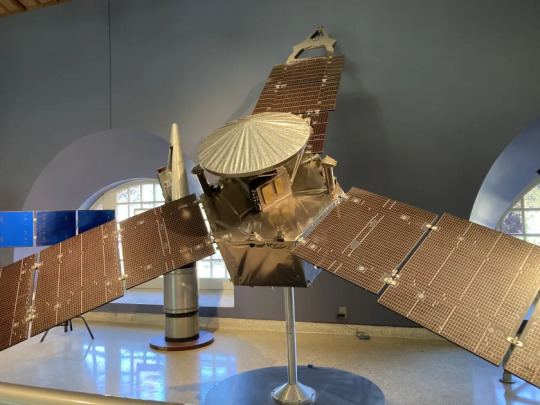
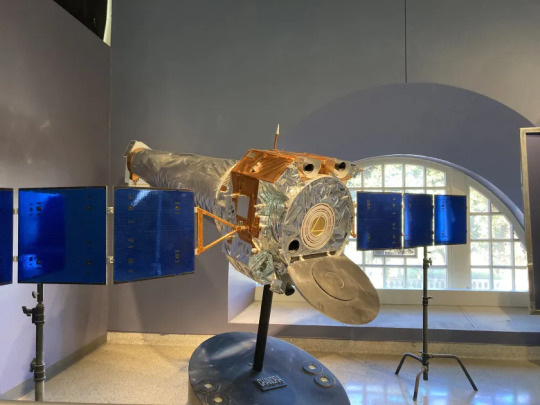

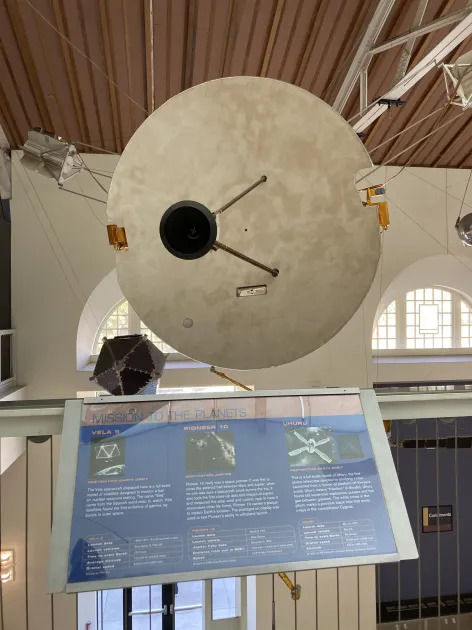

^^ some of my favorite models that they have. when i went here for the first time i remember i was so happy to see hubble and juno
They also had this area where you could use NASA's Eyes on Earth software and it was really cool because they projected the satellites and earth onto a sphere so it was like you could actually view it
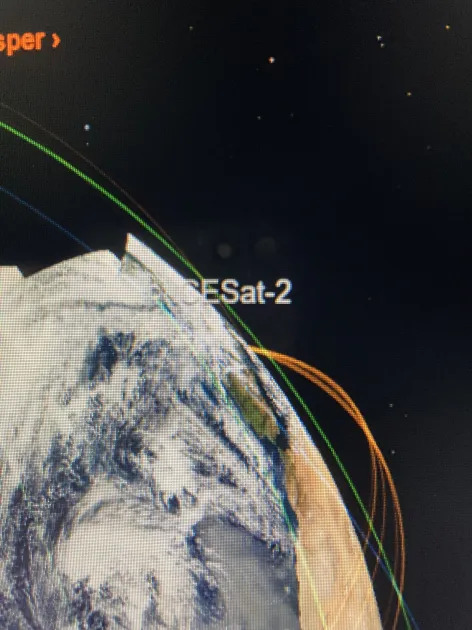
ICESat-2 :D (seeing it made me feel so giddy)


they had so many cool goobers there, even if one of them's a giant space boat <3 (they had a timeline of space shuttle missions and seeing CGRO made me feel happy, i have the mission patch btw lol)
NOW IT'S OFF TO THE GRIFFITH OBSERVATORY !!!
and this time we got to park much closer to the observatory, and we didnt walk eons and eons down the road LOL.

It was a lot more crowded this time but that was probably because it was later and so people might have come to use the telescope at the top of the building.
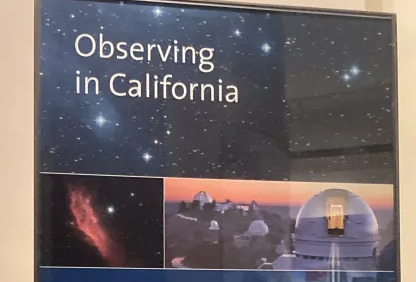
I see what they did there. Nice one. (That's the California Nebula on the left lol. Yes, it's a real name and it's in Perseus)
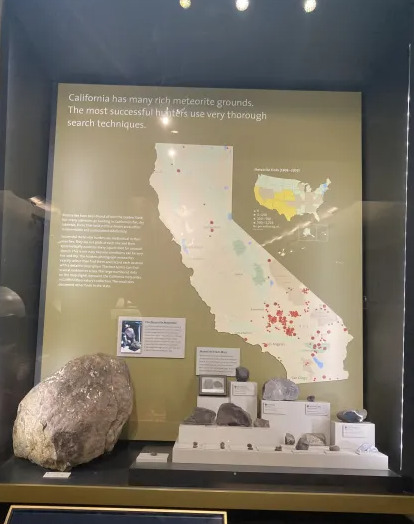

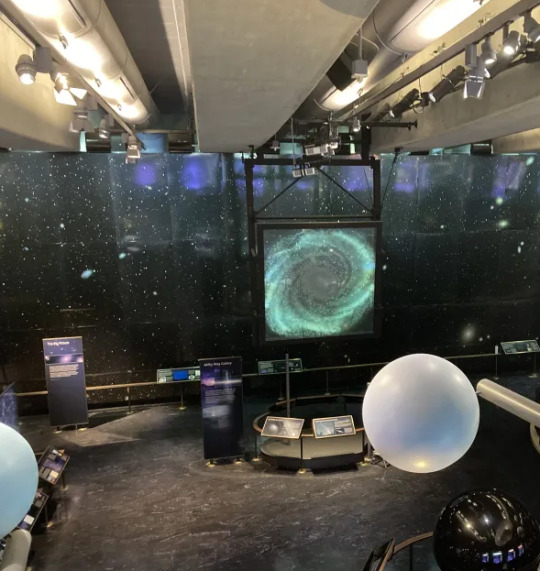
The view from when we left was really pretty,,I love going to these kinds of places :sob: but now im back in good ol' desert Arizona (came back early on saturday) but I LOVE GOI
i think im runnin out of space here so ill continue into some other stuff in another post
December 19th, 2023 - finished writing/posted at 3:18 AM
2 notes
·
View notes
Text
Ughh. I’ve just finished designing my first cross stitch pattern in ministitch, only to discover that you can’t print, convert to pdf, or open the file in any other program. Literally nothing will open a oxs file except software by Ursa. So if I want to get my pattern onto my iPad to stitch it, I have to pay $18 for mobistitch, or $20 for more features in ministitch. And ministitch isn’t actually functional enough that I want to buy more Ursa Software.
I’d much prefer to use Markup R-XP. But Markup can’t open oxs. And you can’t design patterns in Markup.
So right now I’m trying to redo the whole pattern in FlossCross. We’ll see if I have the patience to do it or if I give in and pay.
2 notes
·
View notes
Text

"Ursa Majorly Contorting Itself"
Infinite Painter.
Was playing with 3D mannequin software. The result is a bear contorting its body into an extremely awkward shape and gazing at the stars.
CC-BY-SA 4.0
1 note
·
View note
Text
August 4, 2024. New Moon
Overview of the visibility of constellations and planets

The new moon will occur on August 4 shortly after midday. The Sun and Moon will be in the constellation Cancer, but the Moon will be three and a half degrees north of the Sun. The constellations closest to them — Leo (through which the fastest planets — Venus and Mercury — are currently moving), Sextans, Canis Minor and Hydra — are invisible at this time, due to their proximity to the Sun.

The Moon, although not directly visible, nevertheless has the appearance of an extremely thin crescent, which is inaccessible to the eye. But the most experienced astrophotographers sometimes manage to photograph the Moon — its crescent-shaped reflection — even on the day of the new moon — at the limit of the capabilities of their cameras and software.

Let’s talk about what is available for observation on these days and the calendar dates close to them.
An hour and a half after sunset — above the sector of the horizon where this happened — the stars of the Ursa Major’s Dipper will become most noticeable. Under the handle of the Dipper is the constellation Canes Venatici, and to the left of them is the orange Arcturus — the brightest star in the northern celestial hemisphere and the head of the constellation Bootes. The figure of this constellation extends upward from Arcturus and is similar to the symbol of a parachute, on the lines of which the orange Arcturus descends to the horizon. This descent occurs quite quickly. And in a few minutes you will notice it without difficulty and any devices. Even to the left of Bootes you can find a dim, but noticeable and very beautiful constellation of the Corona Borealis — an arc of faint stars, decorated with a pearl — Gemma. The head of the Serpens stretches toward Gemma — the only constellation on the star map divided into two parts. The Serpent’s Tail is currently located in the southern sky. We will move our gaze there a little later.

Below the constellation Canes Venatici and to the right of Arcturus, the constellation Coma Berenices, not shining with bright luminaries, but very beautiful, leans toward the horizon, in the northern part of which a swarm of stars of medium and low brightness flickers, which does not have an ancient mythological name — only a number in the catalog — Melott 111. But it was this unclear starry glow that ancient people perceived as the luxurious hair of the Egyptian Queen Berenice. This was a sacrifice to the Gods and the price of the return of her husband — the Egyptian king Ptolemy III — from the war as a winner.
___

In the direction of the southern point, you can see the constellation Sagittarius, barely peeking out from behind the horizon. Sagittarius does not rise completely in the middle northern latitudes. Its figure, composed of fairly bright stars, seems dim and inexpressive here due to the absorption of starlight by the atmosphere near the horizon, where in the evenings there is always a lot of dust raised during the day. By morning, the dust settles, but Sagittarius will set behind the horizon much earlier.
To the right of Sagittarius, the “Claws of Scorpius” have almost set behind the horizon — a small part of this constellation visible in the north, but it is among the stars of the “Claws” that the orange-red Antares — “Heart of Scorpius” shines. Together with Scorpius (to the right of it), Libra, which was once only an extension of the sharp and long claws, is also hiding behind the horizon. The stars of Libra still bear the corresponding names — “Northern Claw”, “Southern Claw” — in Arabic, of course.
A bright star shines above Sagittarius — Altair. This is alpha Aquila — one of the main summer constellations. Its figure, composed of stars of medium brightness, really resembles a bird flying in the sky. To the west of the Aquila, there is an extended constellation of Ophiuchus — a constellation very rich in interesting telescopic objects, but poor in stars even of medium brightness. Between Ophiuchus and Aquila, experienced observers can find the constellation Scutum and the very same “Tail of the Serpent”.
To the east and above Altair, you can notice several miniature constellations — Equuleus, Delphinus, Sagitta and Vulpecula (in which on July 30, 2024, a new, but very weak — 10th magnitude — star flared up). These four constellations are located one after the other — following from bottom to top and from left to right near Altair.
___

In the eastern direction, it is easy to notice the huge Square of Pegasus — now it is turned so that it looks more like a Rhombus. Pisces is emerging right from under it — only the alpha of this constellation — Alrisha — remains under the horizon. But it will also rise soon.
To the right of Pisces and Pegasus, Aquarius and a fairly bright Saturn are rising. Neptune is located somewhere near it, but you cannot see it without a telescope — it is a very distant and weak planet. Even further to the right, Capricornus has almost completely risen.
To the right of the Square of Pegasus, there is a chain of stars of the asterism “Head of Pegasus” — it adjoins the Equuleus.
To the left of the Square of Pegasus, there is a chain of stars of the constellation Andromeda. Historically, Pegasus and Andromeda were drawn inseparably on star maps. This continues to this day — the constellations are connected by the star alpha Andromeda — Alpheratz. Previously, it belonged to two constellations at the same time. And above Andromeda, the beautiful and noticeable constellation Cassiopeia is easily recognizable, this season resembling the Latin letter “W”. Below Andromeda, you can see the constellations Triangulum and Aries. Aries has not yet fully risen above the horizon.
___

In the northern part of the sky, the bright Capella, shimmering with all the colors of the rainbow, attracts attention — the brightest star of the constellation Auriga, which belongs to the winter group of constellations. But in the middle northern latitudes, Capella never sets below the horizon.
To the right of Capella, you can see the constellation Perseus, whose brightest star — Mirfak — lies on the continuation of the chain of Andromeda stars and seems to connect Andromeda and Auriga. Closer to the morning, Perseus will rise high in the sky and shower the August night with dozens of sparkling meteors, sometimes called “falling stars.” This meteor shower is called the Perseids, and during its annual activity — from mid-July to the end of August — not a single real star is damaged.
The peak activity of the Perseid shower occurs on the nights from August 11 to 13. The Moon at this time will be located in the evening sky, and will not interfere with pre-dawn observations of meteors.
Above Capella and to the left of Perseus lies the practically starless space of the constellation Camelopardalis. In the city, it will not be possible to discern the figure of this constellation. Lynx, a constellation located between Auriga and Ursa Major, is equally inconspicuous.

Above Capella you can see the North Star and a couple of stars of Ursa Minor that are comparable in brightness. To the right of it, like an upside-down house, is Cepheus, adjacent to Cassiopeia. And between the Ursulas, the Draco runs like a winding river, its tail resting against the Camelopardalis, and its head reaches the very zenith of the summer skies.
___

In the zenith region of the sky are the constellations of Lyra and Cygnus, headed by the bright stars — Vega and Deneb, which together with Altair (located below them in the southern direction) form the famous asterism — the “Summer Triangle”. Cygnus flies with its wings spread wide. At the same time, the left wing points to the “Hooves of Pegasus”, and the right — to the “Head of the Draco” — a small and beautiful trapezoid of medium-brightness stars, adjacent to Vega and the constellation of Hercules, which also has its own stellar trapezoid — so it is called — “Trapezium of Hercules”, and one of the brightest globular star clusters — M13 is hidden from the naked eye in it. There are quite a lot of globular clusters in the summer sky. But the most famous are M13 in the “Trapezium of Hercules” and M15 in the “Head of Pegasus”.
A little to the side of the “Hooves of Pegasus” and the “Tail of the Swan”, in which the bright Deneb burns, there is an inconspicuous constellation of the Lacerta, whose dim stars are unlikely to be seen within the city limits.
___

By two a.m., the Aquarius constellation will rise to its maximum height, and the bright Saturn located in it will be very clearly visible in the southern direction.
To the left of Aquarius and under the highly risen Pisces, Cetus has already fully risen — a large constellation of not very clear configuration, the stars of which seem to split into two groups — the “Head of Cetus” and the “Tail of Cetus”, directed upward and decorated with the alpha of the constellation — the star Menkar. The famous long-period variable star Mira of Cetus is also located in the “Tail”, but it has already passed its annual maximum in May and has already weakened greatly — invisible to the eye.
To the left of Cetus — directly above the point of the east, Taurus is already shining with two bright planets — Jupiter and Mars. Both of these luminaries are located near Aldebaran, the brightest star in Taurus, and form a beautiful triangle with Aldebaran — a few nights ago it was equilateral, but from night to night its proportions change noticeably — the fast Mars is rapidly catching up with Jupiter.

There is another planet in the constellation Taurus now — Uranus. It is not visible to the naked eye, but can be easily found with binoculars a little to the south of the Pleiades — the most beautiful open star cluster in the sky. Another beautiful and bright star cluster — the Hyades — surrounds the orange Aldebaran, which does not belong to the Hyades, because in space it lies approximately halfway from the Sun to the stars of the mentioned cluster.

Directly above the constellation Taurus and the trinity of “Jupiter — Mars — Aldebaran” Perseus looks down from the heavenly heights upon the mortal Earth, holding in his hand the severed head of Medusa the Gorgon, in whose eye the eclipsing variable star Algol — beta Persei slyly winks every three nights. Perseus is known as the illusory source of the Perseid stream. It seems to us that the sparks of the “falling stars” fly to us from this constellation. But in fact, the trajectory of the orbit of the comet Swift-Tuttle is directed in this direction. In July-August of each year, the Earth approaches the orbit of this comet, along which small meteoroids — particles of the disintegrating comet’s core — fly. Some of them meet the Earth and burn up in the atmosphere. On the night of maximum, in an hour of observation, it is possible to notice several dozen (sometimes even up to a hundred) meteors. But they should be observed outside the city, preferably in the mountains.

Just before dawn, the stars of the Gemini constellation, Castor and Pollux, will rise above the northeastern horizon. These are winter stars, but in August some winter constellations already begin to peek out from behind the horizon coulisse, to become fully visible by autumn and for quite a long time.

1 note
·
View note
Text
Mycenaean Pylos & Tiryns (article 0x15/?) WIP

Continuation on this article thread:
Preface
In the reality that is "16^12", Angora is a striking bronze age-themed inhabited planet of stark contrasts within the galactic community. And while at least as far as what the "state of affairs" is during the dawn of their 46th century things are moving along fair nice and sweet at the global scale [...];

Main characters
Kate Kér (self-insert, autistic INTJ brunette, [...] )
Ava Booksword (synthetic-tier android ENFP blonde, starting out as domestic servant by law and eventually earning her way to full citizenship)
Shoshona (black angora housecat)
Nil (second person perspective camera / audience perspective + insertee)
Secondary agents at play
Tano (INTP)
Milan (ENTP)
May (ISTJ)
Sasha (ISTP)
Pana (ISFP)
Valenz (ESTJ)
Ursa (ENFJ)
Elke (INFP)
Miscellaneous personas to account for (13th - 48th) Will add the 36 of them in a further article.
Massive keywords "deque"
Groovy soft natural retro grunge warm natural filmic comfort, tramway at dusk from mesas to the ocean far away, distant future LISP DIY copyleft cartoons, symbolic CAS LISP Gruvbox poetic devkit, soft-rounded bold geometric shape language, fontmap vector prefab modules, slice-of-life cozy rollerwave cartoons, communal retrofuturistic optimism, Bauhaus, Art Deco, Art Nouveau, "Gruvbox Light Medium" + "OldBook Light Academia" mashup, seventies toon cel, copyleft GLOSS data transparency movement, soviet-bloc indie shareware culture, Nintendo 64 console with 64DD expansion cartridge, SEGA Dreamcast, DEC Alpha, Sanyo 3DO TRY, Nuon, Ouya, Commodore PETSCII CBM-II, Commodore Amiga 3000+4000, bronze-age historical time period, Chronokinesis, True Polymorph, lunarpunk mysticism, Teslafunk, Solarpunk, Cyberfunk, syndicalism, georgism, ecology, harmonious innovation, progressives, seventies rollerwave futurism, filmic, OGG container format, OGV, OPUS, Vorbis, OpenEXR, Animated SVG, CSS3 animations, PK3/ZIP file archives, USD format, harsh raster XY plotters & printers, selectric typewriters, comforting Shoshone music / songs / hymns; "Soyuzmultfilm", "Helluva Boss", "The Powerpuff Girls Z", "The Powerpuff Girls", "Jet Set Radio", "Newgrounds", "Jin-Roh The Wolf Brigade", "Android Arts", "Nicky Case", "Jucika", Nintendo 64 with N64DD module, SEGA Dreamcast, Sanyo 3DO, Nuon, Ouya, DEC Alpha, Commodore 64, DECmate II, DECmate III, Intersil 6100 & 6120 lineups, PETSCII, OpenXanadu web, IBM Z/16 Linux One mainframe, OpenPOWER, Libre GLOSS data-transparent Apple Silicon M3 system, RTTY protocols, Minitel / Videotex services, hard-copy terminals, Typex, Telex Teleprinters (read-only & Read/Write), block data terminals, explorable explainers, federated ActivityPub RSS feeds, SPARC Voyager, Xerox Daybreak, R2E Micral Portal, libre bio-modding & cyberware, Pflaumen, Utalics, Lambda Star, Lambda Nova, Wyatt, Sass, MathML, XML+XSL, OpenREXX, PDP-8/e, PDP-12, PDP-15, ALGOL68, LISP 1.5, Steel Bank Common Lisp, Trial Engine, GNU Hurd, Linux, Macroware, SoundTracker, Multi-Agent Simulations, Mixtapes, Android Clades/Classes (Robots, Droids, Synthetics), Open Virtual Worlds, "Rogue Servitors"; "Liberty" caucus within "Union Party", Al-Gore (2000), Trump + Michelle Oprah (2004), Theodore Roosevelt (1912), Charles Hugues (1916), Progressives party since ~1910-1915, Pedro II of Brazil + Haile Selassie equivalent figure during the later 19th century, political split around 2024-2025, female programmers still in charge, gender inclusivity, major 3D, animation & game engine-y frameworks abundant in Common LISP (Trial Engine + AutoLISP as copyleft GLOSS / open source licensed software); Rust red dark grunge wood, translucid glass, matte plastics, fuzzy wool, forest flora, ocean water, arcade cabinets, hyper mall shops & stores, conversation pits, wax cylinder records, 45rpm autoplay mini-vinyl records, datasettes, cassettes, analog Laserdiscs, DECtape, MiniDiscs, programmable androids, retro unit record equipment, mainframes, LTO tape cartridges, amber earmuffs, black spirals-pattern balls, black matte lipstick, cloven hoof shoes; [...]
Soundscapes, music & ambiance playlist
Shoshone Union (So)fi music playlist?
Locations, maps & contextual clues
Beyond Heat Death / Entropy time periods of a far far away past dimension lies questions & their answers we were seeking for... , ?;
0 notes
Photo

Ursa Major Among First Customers for Velo3D’s New Developer Software Tool - 3DPrint.com
0 notes
Text
Night sky highlights for February 2024
Check out the night sky this month, February 2024. Here are videos and articles highlighting the top sights to observe. ** What's Up: February 2024 Skywatching Tips from NASA - NASA JPL What are some skywatching highlights in February 2024? Venus begins its exit from the morning sky, as Mars makes its comeback. Plus, now through May is a good time to observe spiral galaxy M81. 0:00 Intro 0:13 Moon & planet highlights 1:45 Observing spiral galaxy M81 4:01 February Moon phases Additional information about topics covered in this episode of What's Up, along with still images from the video, and the video transcript, are available at https://science.nasa.gov/skywatch.... https://youtu.be/iDAKTLmt2hs ** Tonight's Sky: February 2024 - Space Telescope Science Institute - Tonight's Sky In February, the Winter Triangle is your guide to the night sky: The northern hemisphere is treated to views of the stars Procyon, Sirius, and Betelgeuse. Keep watching for the awe-inspiring space-based views of the Orion Nebula, which is sculpted by the stellar winds of central bright stars. ... “Tonight’s Sky” is a monthly video of constellations you can observe in the night sky. The series is produced by the Space Telescope Science Institute, home of science operations for the Hubble Space Telescope, in partnership with NASA’s Universe of Learning. This is a recurring show, and you can find more episodes—and other astronomy videos—at https://hubblesite.org/resource-galle.... https://youtu.be/0eGB8NApTwo ** What to see in the night sky: February 2024 - BBC Sky at Night Magazine Pete Lawrence and Paul Abel reveal what to see in the night sky tonight and throughout February, including the best comets, clair-obscure effects on the Moon, Orion, Gemini and star clusters. 00:00 Intro 00:13 Mercury, Venus and Mars 02:23 Jupiter and Saturn 03:41 Uranus and Neptune 06:22 Comets 11:25 Einstein Crater 13:34 Lunar X and V, Jewelled Handle 15:31 Orion 16:30 Castor and Pollux 17:50 M35 19:05 Ursa Major 20:15 Leo and the Sickle 22:00 Beehive Cluster 23:06 M67 25:08 Hydra https://youtu.be/fjeGLX3I5aI ** Sky & Telescope's Sky Tour Podcast – February | The Winter Hexagon and Constellations Near Orion - Sky & Telescope Youtube Our monthly Sky Tour #astronomy #podcast provides an informative and entertaining 10-minute guided tour of the nighttime sky. Listen to the February episode and keep tabs on the Moon, say goodbye to a couple of planets, trace out the Winter Hexagon; and explore some lesser-known constellations near Orion. So bundle up, grab your curiosity, and come along on this month’s Sky Tour. https://youtu.be/xE3f1R0wIGk See also - Sky Tour Astronomy Podcast: Upcoming Celestial Events - Sky & Telescope - The Best Comets in 2024 - Sky & Telescope ** What's in the Night Sky February 2024 Venus Mars Conjunction | SpaceX Starlink - Alyn Wallace https://youtu.be/A9uf3LuCzLA ** Night Sky Notebook February 2024- Peter Detterline What's happening in the sky in February 2024 when you look up! https://youtu.be/nos3yHbgQX4 ** See also: - Night Sky Map for February 2024: Orion, the Hunter | Almanac.com - February 2024 Night Sky Calendar | Voyageurs Conservancy - What's in the Sky This Month? | High Point Scientific - The Night Sky in February 2024 | Day By Day Astronomy Events - 4 Must-See Events in the February Night Sky (2024) | SpaceTourismGuide.com - February 2024 night sky: The snow moon, leap year and bright Orion | The Washington Post === Amazon Ads === Celestron 70mm Travel Scope Portable Refractor Telescope Fully-Coated Glass Optics Ideal Telescope for Beginners BONUS Astronomy Software Package == Stellaris: People of the Stars Read the full article
0 notes
Text

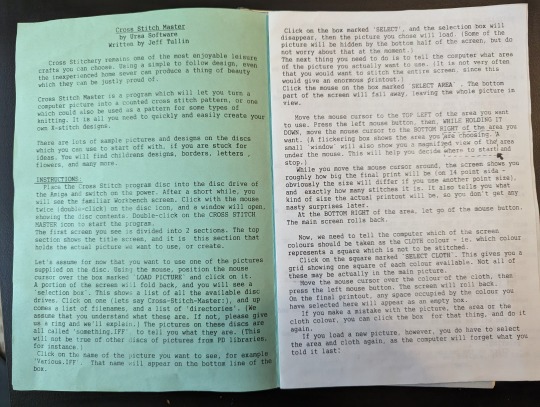

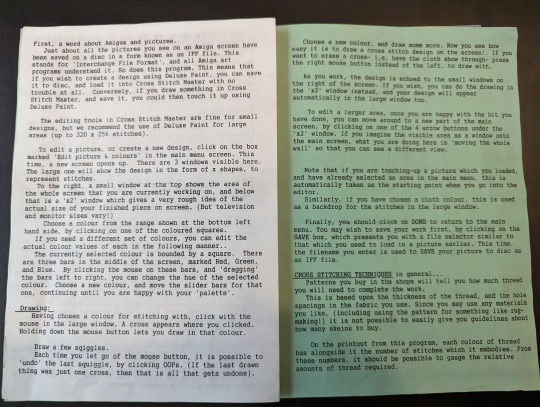
1990s manual for Cross Stitch Master, made by Ursa Software for the Commodore Amiga. Jeff sent these pics to me while I was trying to emulate Cross Stitch Master, and he said I could share them with y'all. :)
#cross stitch#ursa software#commodore amiga#emulation#cross stitch master#retro computing#90s computers
101 notes
·
View notes
Text
Hellohellohello! System blog still isn't showing up in tags so I'm doing it the old fashioned way (using a sideblog that does)
Interest check for a MAP centered around sources/exomemories/hearthomes and similar? It'll be labelled 'exomemory centric' for simplicity's sake but any adjacent experiences are welcome too :]
Very much beginner friendly! Whether you've been animating for years or this is your very first time opening art software, we'd love to have you here!
We'll have a second poll for the song if there ends up being enough interest - we might also look for moderators/cohosts, though that bit I'm not sure about yet! Feel free to leave a comment or reblog if you'd like an update on this later :D
[Authored by OIL (any/all), just stealing Ursa's blog so it'll show up in tags]
#plurality#plural system#pluralgang#endo safe#endo friendly#pro endo#fictionkin#fictive#alterhuman#plural#actually plural#otherkin#open map#beginner friendly#beginner friendly map#beginner map
34 notes
·
View notes
Text
Why Modern Companies are Embracing Odoo for Their ERP Needs

In the ever-evolving landscape of modern business, companies are constantly seeking innovative solutions to streamline their operations, boost productivity, and gain a competitive edge. One such solution that has been gaining widespread attention and adoption is Odoo, an open-source enterprise resource planning (ERP) platform.
In this blog, we’ll explore why Odoo has become the ERP system of choice for many forward-thinking companies, along with statistics, companies thriving in Odoo, and answers to some common questions.
What is Odoo?
Odoo is a powerful business management software that helps companies of all sizes streamline their operations. It offers various modules for tasks like accounting, inventory management, sales, and more.
With its user-friendly interface and customizable features, Odoo makes it easy for businesses to manage everything from customer relations to finances on one integrated platform, boosting efficiency and productivity.
Statistics: The Growing Popularity of Odoo
According to a survey by Odoo, over 4.5 million people use Odoo for their business needs.
Odoo’s community edition has been downloaded over 5 million times.
In 2022, Odoo reported a growth rate of 70%, indicating its rapid adoption in the market.
Modern ERP for Modern Businesses
As businesses grow and diversify, managing operations efficiently becomes increasingly complex. Traditional ERP systems often come with hefty price tags, long implementation times, and rigid structures that don’t adapt well to changing needs.
This is where Odoo stands out:
Cost-Effective Solution: Odoo’s open-source nature means that the software itself is free, significantly reducing upfront costs compared to proprietary ERP systems.
Flexible and Customizable: Odoo’s modular architecture allows businesses to select and customize the exact features they need, making it adaptable to a wide range of industries.
Quick Implementation: Odoo boasts shorter implementation times compared to traditional ERP systems, thanks to its user-friendly interface and extensive library of pre-built modules.
Community Support: With a large and active community of developers and users, Odoo enjoys ongoing enhancements, regular updates, and a wealth of available resources.
Now, let’s delve deeper into why modern companies are embracing Odoo for their ERP needs.
The Rise of Odoo: A Statistical Perspective
To understand the growing popularity of Odoo, let’s take a look at some compelling statistics:
Widespread Adoption: According to Odoo’s official website, over 5 million users and 25,000 businesses have already implemented Odoo across the globe.
Cost Savings: Studies have shown that businesses can save up to 35% on their ERP costs by choosing Odoo over proprietary alternatives. These savings can be invested in other critical areas of the business.
Rapid Growth: Odoo’s revenue has been consistently growing at an impressive rate of 60% year-over-year, as reported in their financial statements.
Companies Thriving with Odoo
Numbers are great, but real-world success stories paint an even more vivid picture. Let’s explore a few examples of companies that have thrived with Odoo:
Ursa: A leading European manufacturer of mineral wool insulation, Ursa implemented Odoo to manage its complex production processes. The result? A 40% reduction in lead times and a 20% boost in productivity.
DreamHarvest: This US-based organic food distributor turned to Odoo to unify their operations, from inventory management to sales. The result? A 30% increase in sales within the first year of implementation.
Salamander: This global footwear brand chose Odoo to integrate their e-commerce and point-of-sale systems. The outcome? A 50% reduction in manual data entry and a 25% boost in sales.
Flecto Industries is a medium-sized manufacturing company that struggles with inefficiencies in its production process.
BloomRetail is a retail startup that faces challenges managing its inventory across multiple locations. Odoo’s inventory management module provided real-time insights, helping BloomRetail optimize its stock levels and reduce excess inventory by 20%.
TechSol Services is an IT services provider that needed to streamline its project management and resource allocation. With Odoo’s project management module, TechSol Services improved project delivery timelines by 25% and achieved a 10% increase in client satisfaction.
Wrapping Up
In an era where agility and efficiency are paramount for business success, Odoo has emerged as a versatile and cost-effective ERP solution that empowers modern companies to thrive. Its modular design, ease of use, scalability, and integration capabilities make it an attractive choice for businesses of all sizes and industries. As we’ve seen through statistics and real-world examples, Odoo is not just software; it’s a strategic asset that can revolutionize the way companies operate.
Meghsundar, a leading Odoo implementation company
Contact us to meet our amazing and productive portfolio.
0 notes
Text
Research Day 9, Blog 9
Title: A Productive Day in the Lab: Exploring Single-Step Debugging, Python Classes, and Astronomical Analysis
Introduction: Thursday, May 25, was an exhilarating day in our research lab as we delved into various topics, including single-step debugging, Python classes and object-oriented programming (OOP), and astronomical image analysis. This blog post provides a glimpse into our productive day and highlights the key takeaways from each session.
Updating Lab Notebooks and Capturing M101: We kicked off the day by updating our lab notebooks with notes from a presentation we attended the previous day on "How to Present to a Non-Technical Audience". These notes served as a valuable reference for our ongoing research. Additionally, we recorded the data we collected the previous evening when we ventured out to take pictures of the night sky, specifically aiming to capture M101, a beautiful spiral galaxy located in the Ursa Major constellation.
Exploring Single-Step Debugging: Following the notebook update, we engaged in a comprehensive revision session on single-step debugging. This debugging technique enables programmers to execute code one step at a time, making identifying and rectifying errors easier. By carefully observing the program's behavior at each step, we better understood its execution flow and pinpointed any potential issues. Single-step debugging proved to be an effective tool in our software development process.
Diving into Python Classes and OOP: The next segment of our day was dedicated to a discussion on Python classes and OOP. Object-oriented programming is a powerful paradigm that allows for efficient code organization, reusability, and modularity. We explored the fundamental concepts of classes, objects, inheritance, and encapsulation. This discussion expanded our programming toolkit and opened up new possibilities for structuring our codebase.
Re-implementing Our Algorithm Using Classes: Building upon our knowledge of Python classes, we embarked on the exciting task of re-implementing our existing algorithm using the principles of OOP. By encapsulating related data and functions within classes, we were able to achieve a more organized and maintainable code structure. This approach also facilitated code reuse and abstraction, making our algorithm more adaptable and scalable.
Astronomical Analysis: Analyzing Night Sky Pictures: To conclude our productive day, we analyzed some of the captivating pictures we captured the previous night using astronomical websites and specialized software. These tools helped us identify celestial objects, such as stars, galaxies, and nebulae, in our images. By cross-referencing our findings with existing astronomical databases, we gained valuable insights into the objects we observed. This analysis reinforced the importance of astronomical data processing techniques in our research and deepened our understanding of the cosmos.
Conclusion: Thursday, May 25, proved to be a remarkable day in our research journey. We started by updating our lab notebooks, followed by an in-depth revision on single-step debugging and an engaging discussion on Python classes and OOP. We then applied our newfound knowledge to re-implement our algorithm, leveraging the power of classes for better code organization and scalability. Finally, we analyzed the breathtaking images of the night sky, connecting our research to the wonders of the universe. This productive day served as a stepping stone towards further discoveries and advancements in our scientific pursuits.
1 note
·
View note
Photo




“Arg! Is there an easy way to view images through a grid?” So, I searched for almost exactly that phrase and found an online grid making program...
Went in without a specific goal in mind, so I looked up a topographical map of Arizona to mess around with. I should’ve tweaked the colors differently to get more contrast, but got a rough pattern to output; I think I left out a deeper green, and had trouble keeping track of my oranges.
Only an hour or so of work left for the day, but maybe I’ll start stitching this to see how it looks.
6 notes
·
View notes
Text
5 razones por las que todo el mundo habla de BIM
Cada día recibimos en nuestro correo electrónico noticias, ofertas de formación, presentaciones sobre la tecnología BIM. Si algo nos ha sorprendido es lo rápido que han reaccionado los distintos actores del sector de la edificación a la hora de incorporar el nuevo lenguaje a su dinámica laboral. Los fabricantes de materiales de construcción han actuado de forma rápida para completar sus bibliotecas con todas sus gamas descritas en BIM.
[...]
#aparejo#BIM#construcción#digital#diseño#diseño ordenador#enseñanza#estudiante#formatos digitales#gestión#herramienta#joven arquitecto#joven valor#máster#planificacion#procesos digitales#profesión#representación#software libre#URSA
2 notes
·
View notes